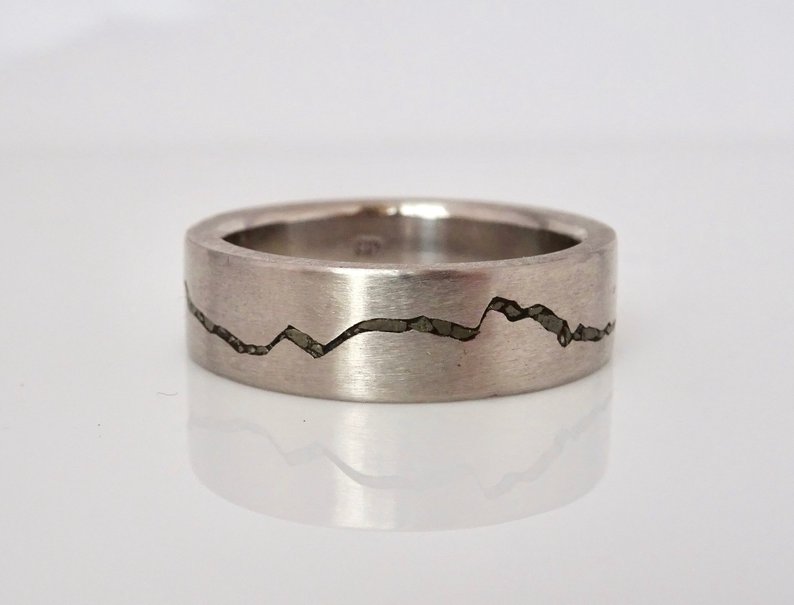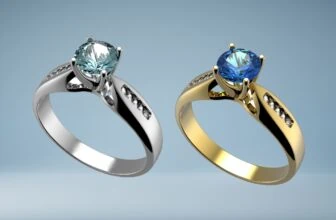
Table of Contents
You might have guessed where the word Pyrite comes from – it’s the Greek word for fire. But pyrite isn’t called that because of its fiery color, however – it’s called pyrite because it produces sparks when knocked.
Visually, pyrite often resembles gold with its pale-brass yellow hue and metallic shine, and for centuries people had been tricked by the resemblance. But today, it’s respected as a stone in its own right and beautiful pyrite jewelry is highly sought after.
So, what exactly is pyrite and how should you evaluate the gemstone? Let’s take a look at this pyrite buying guide.
What is a Pyrite?
Chemically, pyrite is an iron sulfide. It’s considered to be one of the most common sulfide materials and it has been used for centuries as an ore of iron. Its brass color has earned it names such as brass, Brazzle, or Brazil, which are usually used to refer to the pyrite found in coal.
Bravoite, on the other hand, is a nickel-cobalt-bearing variety of pyrite. It is widely known as Fool’s Gold, because of its close resemblance to gold which can trick people. Funnily enough, pyrite is sometimes found with trace quantities of actual gold in it. In some deposits such as the Carlin-type gold deposits, pyrite can contain up to 0.37% gold by weight.
The crystal formations of pyrite are easy to distinguish as they form in cuboid shapes, often in close proximity to one another. When that happens, pyrite formations create pretty raspberry-shaped crystal formations called framboids of form in a cube and semi-cube shapes.

Pyrite has been used as a source of ignition in firearms in the 16th and 17th centuries thanks to its ability to easily create sparks when struck. Pyrite has also been used and can be used for various other purposes such as the production of lithium batteries, radio receivers, solar panels and solar cells, and so on.
Today, the Chinese market is the main importing country when it comes to pyrite as they import roughly 376,000 tons per year, which is about 45% of the total global pyrite imports.
How To Choose Pyrite Color
Pyrite’s color can range from a brighter golden yellow to a paler grey color. This is largely dependent on the inclusions present within the stone. Pyrite also has a unique metallic luster and shine which adds to its overall beauty.

No one variety of pyrite color is more valuable than another. It’s a matter of preference whether you opt for a golden or more metallic color.
Pyrite and Clarity
As an iron sulfide that resembles gold, clarity is clearly not something pyrite is known for. It has no transparency and is opaque in nature. Certain inclusions can affect its color and its metallic luster.
Pyrite Cut
Pyrite is rather brittle in nature, so cutting it requires quite a lot of care. It’s often cut in cabochons, beads, and faceted shapes. Because of its lack of clarity and its homogenous opaque look, pyrite can cut in any shape as long as the physical integrity of the piece is maintained.

Something unique about natural pyrite is how it can occur in perfectly cubic shapes. It can look like a stone shaped and polished by a jeweler but is in fact, mined in that manner. This makes pyrite quite distinct, even though it’s a common and inexpensive element.
Pyrite can also be cut into various faceted shapes or shaped into small figurines. These are often like the older marcasite jewelry that was popular in the Victorian era. Regardless of the cut or the shape, pyrite pieces of all cuts and sizes can be found at any jeweler at affordable prices.
Pyrite Carat Sizes
Pyrite can be found in a variety of carat sizes, and as it’s very common and inexpensive, the size of the stone isn’t significantly correlated to its price. In general, pyrite pieces are measured in millimeters instead of carat sizes, as is common with most gemstones.
Pyrite in Jewelry
Pyrite is typically used in costume jewelry and bead jewelry. It makes for eye-catching statement pieces and its versatility means that it can be used in a variety of jewelry styles, from boho and hippie to high-end and chic.

Pyrite and gold-colored metals make for a fantastic and stylish combination, perfect for a formal event. For a dressed-up look, pick dangle earrings, cocktail rings, and statement necklaces. However, you can tone it down with minimalist-style jewelry, including simple pyrite stud earrings and bead jewelry.


Pyrite can also be incorporated into special jewelry like wedding bands in the form of inlays. Pyrite engagement rings aren’t recommended as it’s not a highly durable stone. However, with proper care and reasonable maintenance, a pyrite engagement ring can last for a long time.

In the past, pyrite was typically used in “marcasite” jewelry, as marcasite is a variety of pyrite. This type of jewelry is made from small faceted pieces of iron sulfides set in silver. This style was very common in ancient times as well as in the Victorian era. Despite its low price due to the affordable materials, marcasite jewelry can actually be very beautiful when cut and designed well. There are a lot of gorgeous artisan pieces of marcasite jewelry on sites like Etsy, so checking them out can be quite worth it.
Fool’s Gold vs. Real Gold

Many people mistake pyrite for gold, so knowing the difference between these two elements is important. While visually they may appear similar, there are in fact, many differences between the two.
Here are some:
- Pyrite shatters and crumbles if dealt a hard blow. Gold, on the other hand, tends to bend rather than break. Gold is malleable, unlike pyrite which is brittle.
- Pyrite is much harder than gold, ranking 6 to 6.5 on the Mohs scale. Gold only ranks at 2.5 to 3. This means that gold can be scratched and changes shape easily, whereas pyrite is much more durable.
- If you rub a pyrite rock, you might typically get some greenish or black-colored residue on your finger, similar to lead. Gold nuggets don’t have similar residue.
- Observe the way light interacts with the specimen. If it’s gold, there tends to be a shine from all angles whereas pyrite exhibits more of a hard glitter, and often only from certain angles. In this case, all that glitters truly isn’t gold.
- Look at the edges of the specimen. Gold tends to have rounded edges while pyrite’s are more angular and sharper.
Cleaning and Caring for Pyrite Jewelry
Pyrite has an average hardness, with a Mohs ranking of 6 to 6.5. Depending on the type of jewelry, cleaning pyrite requires a lot of care. Marcasite jewelry especially requires careful maintenance as the little pyrite pieces can get dislodged and fall out.
Pyrite jewelry can be cleaned with warm water and mild liquid soap, using a soft cloth or brush. Avoid abrasive materials or harsh chemicals as these can damage the surface of the stone.
If you have marcasite jewelry which includes silver, then care for the piece as you would for silver jewelry. Use a soft and damp piece of cloth with a very weak and non-toxic cleaning solution. Carefully rub every element without applying too much pressure.
Also, remember to always store your pyrite jewelry separately from other pieces of jewelry or, at least, preserved in a piece of cloth, as both pyrite, silver, and many gemstones used in marcasite can easily be hurt by other harder metals and minerals.
Enhanced or Imitation Pyrite Gemstones
Pyrite isn’t typically enhanced or treated in any way. It also doesn’t have notable imitations simply because there’s no point in trying to imitate pyrite. The opposite is true, however – pyrite has been used by jewelers as an imitation of gold for centuries.
Pyrite Meaning and Symbolism
Pyrite is valued by those who believe in crystal healing for bringing in good energy to the wearer. It’s often lauded as a must-have piece for offices and workplaces because it’s a symbol of wealth and good luck.
Pyrite is believed to block negative energy and keep you safe from physical danger. Pyrite is also seen as an environmental stone and one that can protect you from environmental pollution. It’s also supposed to provide a connection to Mother Nature and thus – help you when you lack inspiration and mental strength.
*Disclaimer: Jewelry Shopping Guide does not guarantee or validate any of the claims related to the metaphysical and alternative healing powers of this or any other gemstone. This information should in no way be used as a substitute for medical advice.
Where to Buy Pyrite
Pyrite is easily available and very affordable. You’ll be able to find pyrite jewelry and loose stones in shops that specialize in gemstones and crystals.
A simple search online will reveal numerous pyrite jewelry options. We recommend searching on Etsy and Amazon for some amazing handmade pyrite jewelry at competitive prices.









